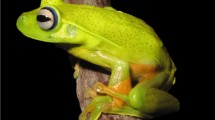Abstract
Based on statistical analyses of song sequences, Bengalese finch (Lonchura striata var. domestica) songs do not show unvarying motif repetition as has been found in zebra finches (Taeniopygia guttata). Instead, there are variations of partially stereotyped sequences of song syllables. Although these stereotyped sequences consist of multiple syllables, in most cases these syllables occur together. To examine whether such structures really exist as a vocal production unit, we subjected singing birds to a light flash and determined when the stimulus stopped the songs. When light interruptions were presented within the statistically stereotyped sequences, the subsequent syllables tended to be produced, whereas interruptions presented during the statistically variable sequences tended to cause instantaneous song termination. This suggests that the associations among the song syllables that compose the statistically stereotyped sequences are more order dependent than those for the statistically variable sequences, and the tolerances of syllable pairs to visual interruptions are consistent with the statistical song structures. Additionally, following interruptions, several types of song sequence variations were observed that had not been previously reported. These phenomena might be caused by various effects of the visual stimulus on the hierarchical motor control program.








Similar content being viewed by others
References
Bischof HJ, Engelage J (1985) Flash evoked responses in a song control nucleus of the zebra finch (Taeniopygia guttata castanotis). Brain Res 326:370–374
Böhner J (1990) Early acquisition of song in the zebra finch, Taeniopygia guttata. Anim Behav 39:369–374
Clayton NS (1987) Song learning in Bengalese finches: a comparison with zebra finches. Ethology 76:247–255
Cynx J (1990) Experimental determination of a unit of song production in the zebra finch (Taeniopygia guttata). J Comp Psychol 104:3–10
Cynx J, von Rad U (2001) Immediate and transitory effects of delayed auditory feedback on bird song production. Anim Behav 62:305–312
Franz M, Goller F (2002) Respiratory units of motor production and song imitation in the zebra finch. J Neurobiol 51:129–141
Gentner TQ (2004) Neural systems for individual song recognition in adult birds. Ann NY Acad Sci 1016:282–302
Gentner TQ, Fenn KM, Margoliash D, Nusbaum HC (2006) Recursive syntactic pattern learning by songbirds. Nature 440:1204–1207
Honda E, Okanoya K (1999) Acoustical and syntactical comparisons between songs of the white-backed munia (Lonchura striata) and its domesticated strain, the Bengalese finch (Lonchura striata var. domestica). Zool Sci 16:319–326
Hoshino T, Okanoya K (2000) Lesion of a higher-order song nucleus disrupts phrase level complexity in Bengalese finches. NeuroReport 11:2091–2095
Hultsch H, Todt D (1989) Memorization and reproduction of songs in nightingales (Luscinia megarhynchos): evidence for package formation. J Comp Physiol A 165:197–203
Immelmann K (1969) Song development in the zebra finch and other estrildid finches. In: Hinde RA (ed) Bird vocalizations, Cambridge University Press, Cambridge, pp 61–77
Margoliash D (1983) Acoustic parameters underlying the responses of song-specific neurons in the white-crowned sparrow. J Neurosci 3:1039–1057
Miller TC, Flusberg S, Hauser MD (2003) Interruptibility of long call production in tamarins: implications for vocal control. J Exp Biol 206:2629–2639
Nordeen KW, Nordeen EJ (1992) Auditory feedback is necessary for the maintenance of stereotyped song in adult zebra finches. Behav Neural Biol 57:58–66
Nottebohm F, Stokes TM, Leonard CM (1976) Central control of song in the canary, Serinus canaries. J Comp Neurol 165:457–486
Okanoya K (2004) Song syntax in Bengalese finches: proximate and ultimate analyses. Adv Study Behav 34:297–346
Okanoya K, Yamaguchi A (1997) Adult Bengalese finches (Lonchura striata var. domestica) require real-time auditory feedback to produce normal song syntax. J Neurobiol 33:343–356
Price P (1979) Developmental determinants of structure in zebra finch song. J Comp Physiol Psychol 93:260–277
Riebel K, Todt D (1997) Light flash stimulation alters the nightingale’s singing style: implications for song control mechanisms. Behaviour 134:789–808
Sakata JT, Brainard MS (2006) Real-time contributions of auditory feedback to avian vocal motor control. J Neurosci 26:9619–9628
Seki Y, Okanoya K (2006) Effects of visual stimulation on the auditory responses of the HVC song control nucleus in anesthetized Bengalese Finches. Ornithol Sci 5:39–46
Sossinka R, Böhner J (1980) Song types in the zebra finch. Z Tierpsychol 53:123–132
ten Cate C, Ballintijn MR (1996) Dove coos and flashed lights: interruptibility of “song” in a nonsongbird. J Comp Psychol 110:267–275
Thorpe WH (1958) The learning of song patterns by birds, with special reference to the song of the Chaffinch, Fringilla coelebs. Ibis 100:535–570
Vu ET, Mazurek ME, Kuo YC (1994) Identification of a forebrain motor programming network for the learned song of zebra finches. J Neurosci 14:6924–6934
Wild JM (1994) Visual and somatosensory inputs to the avian song system via nucleus uvaeformis (Uva) and a comparison with the projections of a similar thalamic nucleus in a nonsongbird, Columba livia. J Comp Neurol 349:512–535
Wild JM (2004) Functional neuroanatomy of the sensorimotor control of singing. Ann NY Acad Sci 1016:438–462
Woolley SMN, Rubel EW (1997) Bengalese finches Lonchura striata domestica depend on auditory feedback for the maintenance of adult song. J Neurosci 17:6380–6390
Yu AC, Margoliash D (1996) Temporal hierarchical control of singing in birds. Science 273:1871–1875
Acknowledgments
We thank Satoru Teramoto and Koji Nakamura for their help with the pilot studies of this experiment, we thank N. Kutsukake, S.Yoshida, M. Soma for valuable suggestions. Part of this study was supported by PREST, JST to KO. This experiment was approved by the RIKEN Animal Experiments Committee.
Author information
Authors and Affiliations
Corresponding author
Rights and permissions
About this article
Cite this article
Seki, Y., Suzuki, K., Takahasi, M. et al. Song Motor control organizes acoustic patterns on two levels in Bengalese finches (Lonchura striata var. domestica). J Comp Physiol A 194, 533–543 (2008). https://doi.org/10.1007/s00359-008-0328-0
Received:
Revised:
Accepted:
Published:
Issue Date:
DOI: https://doi.org/10.1007/s00359-008-0328-0




